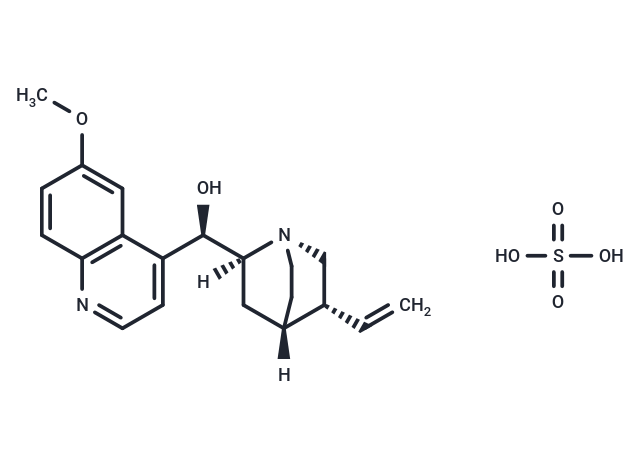Shopping Cart
- Remove All
 Your shopping cart is currently empty
Your shopping cart is currently empty

Quinidine sulfate, an antiarrhythmic agent, is a potent, orally active, selective cytochrome P450db inhibitor and a K+ channel blocker with an IC50 of 19.9 μM. It can also be used for malaria research [1] [2] [3].

| Pack Size | Price | Availability | Quantity |
|---|---|---|---|
| 10 mg | Inquiry | 10-14 weeks | |
| 50 mg | Inquiry | 10-14 weeks |
| Description | Quinidine sulfate, an antiarrhythmic agent, is a potent, orally active, selective cytochrome P450db inhibitor and a K+ channel blocker with an IC50 of 19.9 μM. It can also be used for malaria research [1] [2] [3]. |
| In vitro | Quinidine sulfate is an anti-arrhythmic drug that influences ionic currents in heart muscle and acts as a potent blocker of several classes of K+ channels in various cell types [1]. Bath application of quinidine sulfate reduces the peak amplitude of I k in a dose-dependent manner, with a K d for blockade of I k at 0 mV estimated to be 41 μM [1]. Quinidine sulfate increases the rate of I k decay dose-dependently, an effect enhanced by membrane depolarization. It also causes a 5 mV hyperpolarizing shift of the steady-state inactivation curve and prolongs the half-time for recovery from inactivation, without affecting the onset of inactivation measured at -30 mV [1]. |
| In vivo | Quinidine sulfate is rapidly absorbed, reaching peak plasma concentrations 60-90 minutes after oral administration. In contrast, other salts (gluconate, polygalacturonate) are absorbed more slowly with lower peak concentrations [2]. Approximately 70-90% of quinidine sulfate is bound to plasma proteins, and it undergoes hepatic oxidative metabolism to form an N-oxide, a 3-hydroxy form, an O-demethyl form, and 2'-quinidinone [2]. Quinidine sulfate inhibits amphetamine metabolism in rats, with pretreatment significantly decreasing p-hydroxyamphetamine excretion at 24 and 48 hours to 7.2% and 24.1% of control levels, respectively, and significantly increasing amphetamine excretion at 24-48 hours to 542% of control [3]. |
| Molecular Weight | 422.49 |
| Formula | C20H26N2O6S |
| Cas No. | 549-56-4 |
| Storage | Powder: -20°C for 3 years | In solvent: -80°C for 1 year | Shipping with blue ice. |

Copyright © 2015-2025 TargetMol Chemicals Inc. All Rights Reserved.